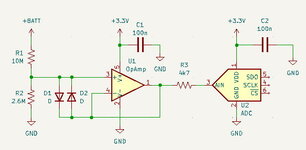Eight
Member level 2
Hello.
I'm designing a circuit to measure DC voltages that can be higher than what the ADC can handle. I already did some searching/googling, but I'd like to ask someone to verify, if what I'm doing is correct. The measured voltage span should be from 0 to 16V DC, and I only need continuous low-speed measurements of DC (battery voltage).
Obviously, I will need a two-resistor voltage divider to bring the measured voltage down to acceptable levels (the single-ended ADC can only go up to 3.3V). The first question is how high resistor values to use. Most ADC's require some maximum source impedance for accurate measurements (usually up to 10 kOhm). But since this is going to be a battery powered application I would like to minimize the current flow through this voltage divider - this means resistor values should be in range of some megaohms. Unfortunately those values will result in a current that is insufficient for the ADC. Therefore, the source should be buffered by an opamp in a unity-gain voltage follower configuration. Finally, I'd like to add some overvoltage protection to the opamp input as a good measure.
Attached is the circuit that I came up with.
I'm not sure what type of diodes to use except that they should be low-leakage (someone suggested junction diode?).
Any other thoughts, suggestions?
Thanks in advance!
I'm designing a circuit to measure DC voltages that can be higher than what the ADC can handle. I already did some searching/googling, but I'd like to ask someone to verify, if what I'm doing is correct. The measured voltage span should be from 0 to 16V DC, and I only need continuous low-speed measurements of DC (battery voltage).
Obviously, I will need a two-resistor voltage divider to bring the measured voltage down to acceptable levels (the single-ended ADC can only go up to 3.3V). The first question is how high resistor values to use. Most ADC's require some maximum source impedance for accurate measurements (usually up to 10 kOhm). But since this is going to be a battery powered application I would like to minimize the current flow through this voltage divider - this means resistor values should be in range of some megaohms. Unfortunately those values will result in a current that is insufficient for the ADC. Therefore, the source should be buffered by an opamp in a unity-gain voltage follower configuration. Finally, I'd like to add some overvoltage protection to the opamp input as a good measure.
Attached is the circuit that I came up with.
I'm not sure what type of diodes to use except that they should be low-leakage (someone suggested junction diode?).
Any other thoughts, suggestions?
Thanks in advance!
